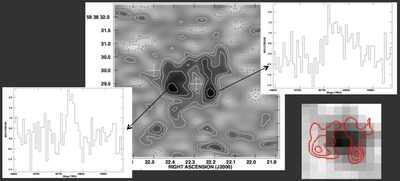A Molecular Einstein Ring at z = 3.93 Submillimeter Galaxy MM18423+593
Investigators: Jean-Francois Lestrade (1), Chris L. Carilli (2), Karun Thanjavur (3,4), Jean-Paul Kneib (5), Dominik Riechers (6), Frank Bertoldi (7), Fabian Walter (8), Alain Omont (9)
(1) Observatoire de Paris, (2) NRAO, (3) CFHT, (4) Univ Victoria, (5) Laboratoire d’Astrophysique de Marseille, (6) Caltech, (7) Argelander Institute for Astronomy, Univ Bonn, (8) Max-Planck Institute for Astronomy, (9) Institut d’Astrophysique.
 We present high resolution imaging of the low order (J=1 and 2) CO line emission from the z = 3.93 submillimeter galaxy (SMG) MM18423+5938 using the Expanded Very Large Array, and optical and near-IR imaging using the Canada-France-Hawaii Telescope. This SMG with a spectroscopic redshift was thought to be gravitationally lensed given its enormous apparent brightness. We find that the CO emission is consistent with a complete Einstein ring with a major axis diameter of ~1.4′′, indicative of lensing. We have also identified the lensing galaxy as a very red elliptical coincident with the geometric center of the ring and estimated its photometric redshift z 1.1. A first estimate of the lens magnification factor is m~12. The luminosity L′_CO(1−0) of the CO(1−0) emission is 2.71±0.38x10^11/m K km s^−1 pc^2, and, adopting the commonly used conversion factor for ULIRGs, the molecular gas mass is M(H2) = 2.2x10^11/m M⊙, comparable to unlensed SMGs if corrected by m ~ 12. Our revised estimate of the far-IR luminosity of MM18423+5938 is 2 x 10^13/m < L_FIR < 3x10^14/m L⊙, comparable to that of ULIRGs. Further observations are required to quantify the star formation rate in MM18423+5938 and to constrain the mass model of the lens in more detail.
We present high resolution imaging of the low order (J=1 and 2) CO line emission from the z = 3.93 submillimeter galaxy (SMG) MM18423+5938 using the Expanded Very Large Array, and optical and near-IR imaging using the Canada-France-Hawaii Telescope. This SMG with a spectroscopic redshift was thought to be gravitationally lensed given its enormous apparent brightness. We find that the CO emission is consistent with a complete Einstein ring with a major axis diameter of ~1.4′′, indicative of lensing. We have also identified the lensing galaxy as a very red elliptical coincident with the geometric center of the ring and estimated its photometric redshift z 1.1. A first estimate of the lens magnification factor is m~12. The luminosity L′_CO(1−0) of the CO(1−0) emission is 2.71±0.38x10^11/m K km s^−1 pc^2, and, adopting the commonly used conversion factor for ULIRGs, the molecular gas mass is M(H2) = 2.2x10^11/m M⊙, comparable to unlensed SMGs if corrected by m ~ 12. Our revised estimate of the far-IR luminosity of MM18423+5938 is 2 x 10^13/m < L_FIR < 3x10^14/m L⊙, comparable to that of ULIRGs. Further observations are required to quantify the star formation rate in MM18423+5938 and to constrain the mass model of the lens in more detail.
Publication: Accepted for ApJ Letters, to appear in the ApJL EVLA special issue. arVix:1106.1432v1




Connect with NRAO